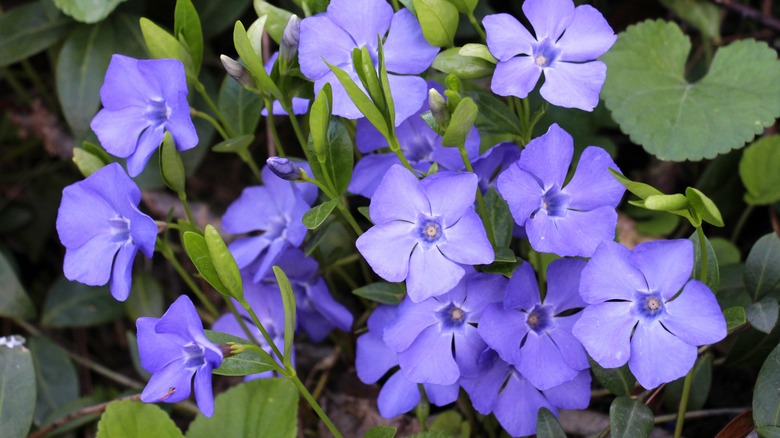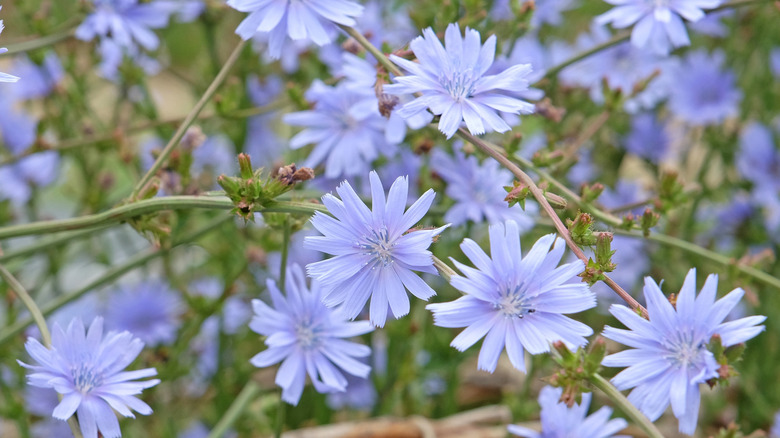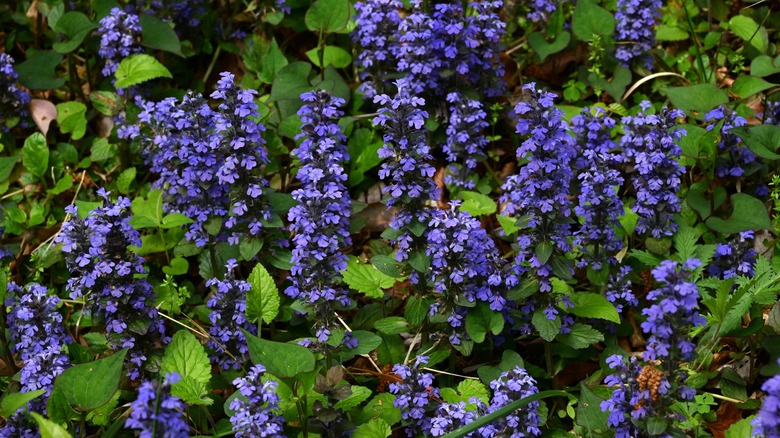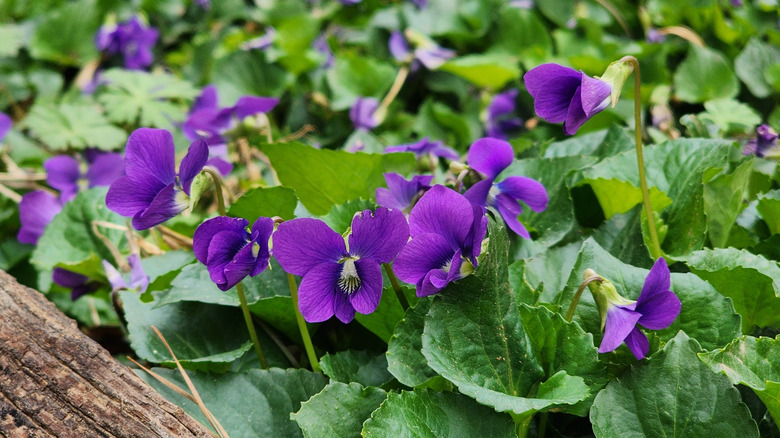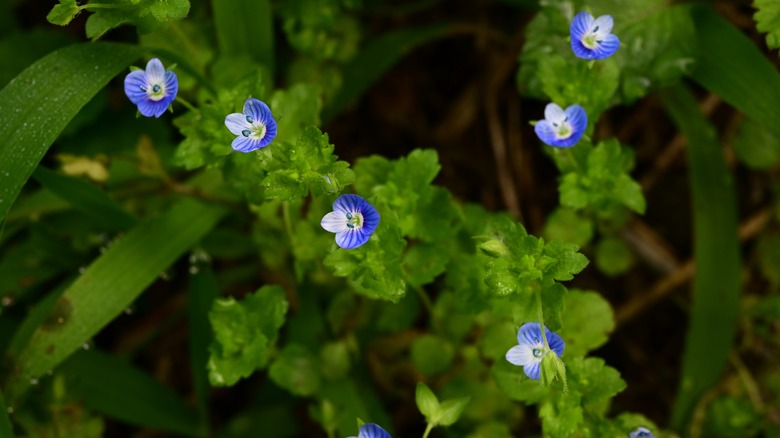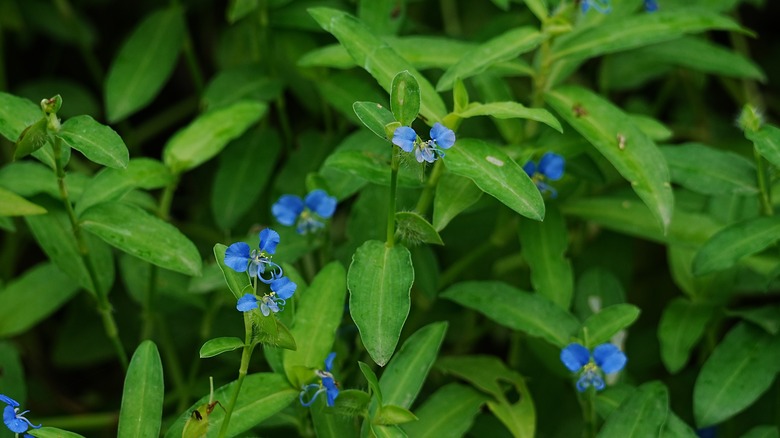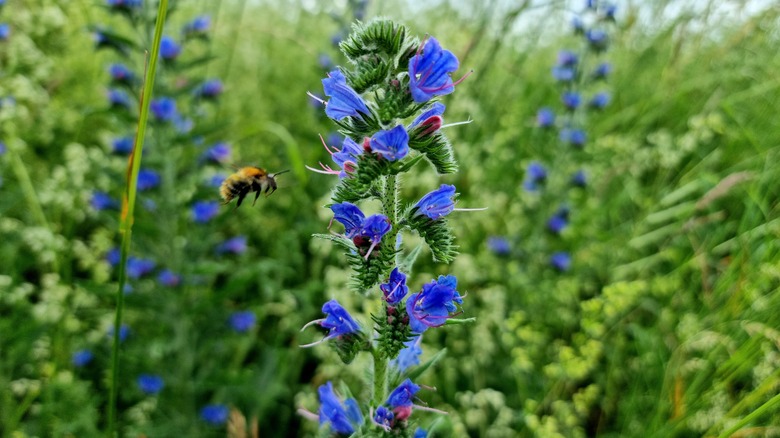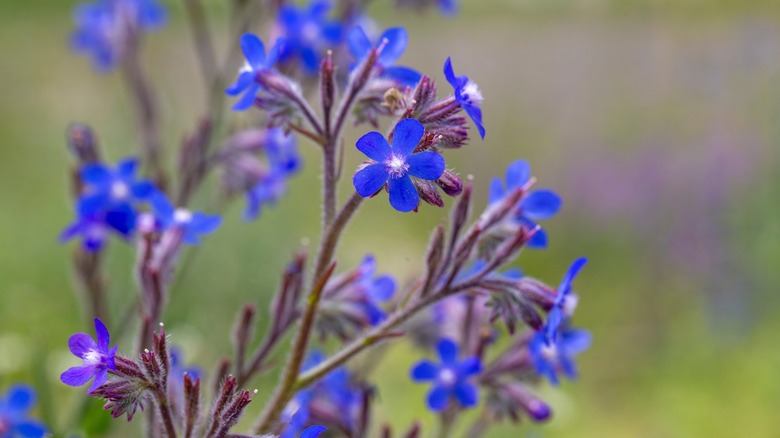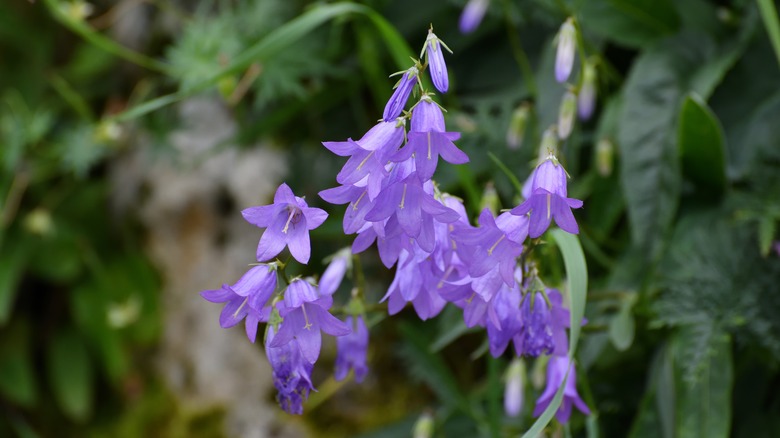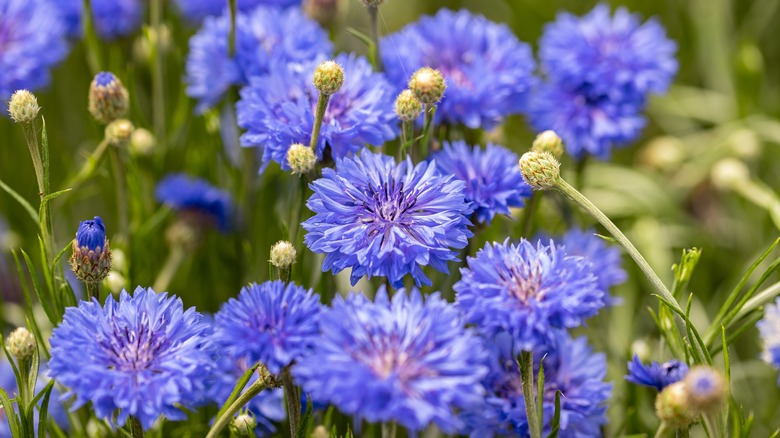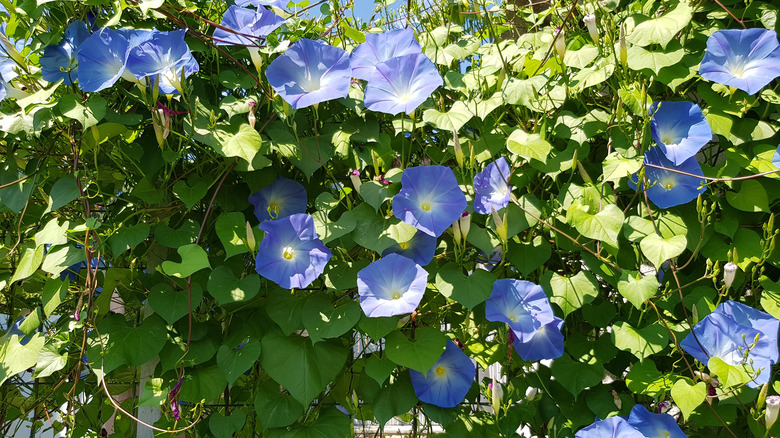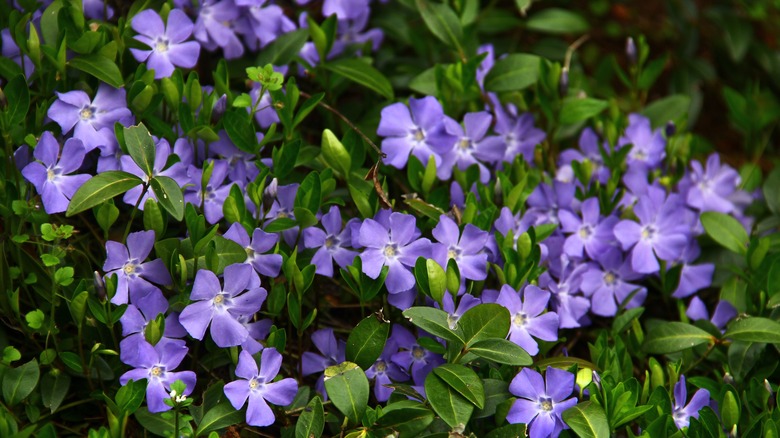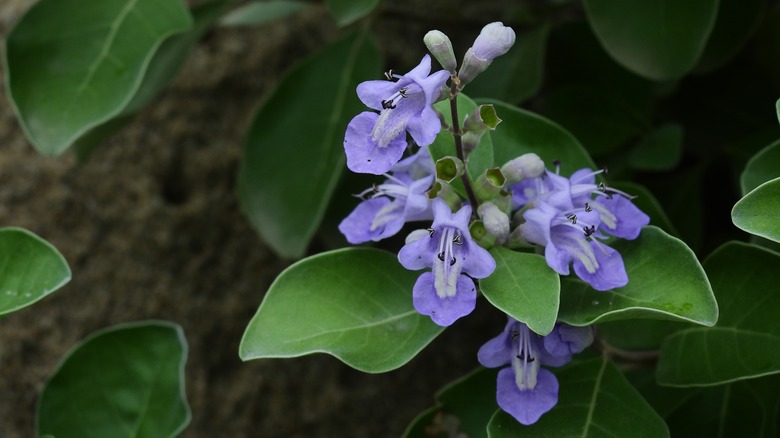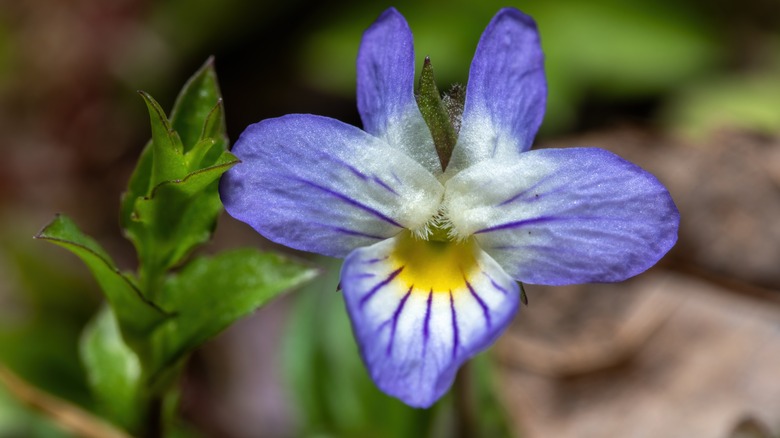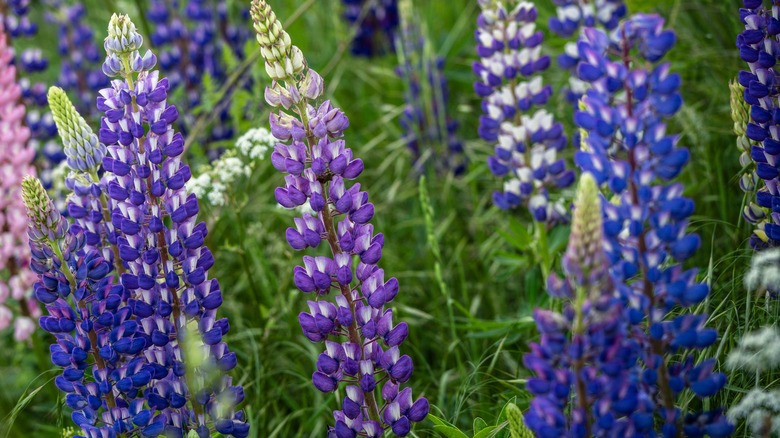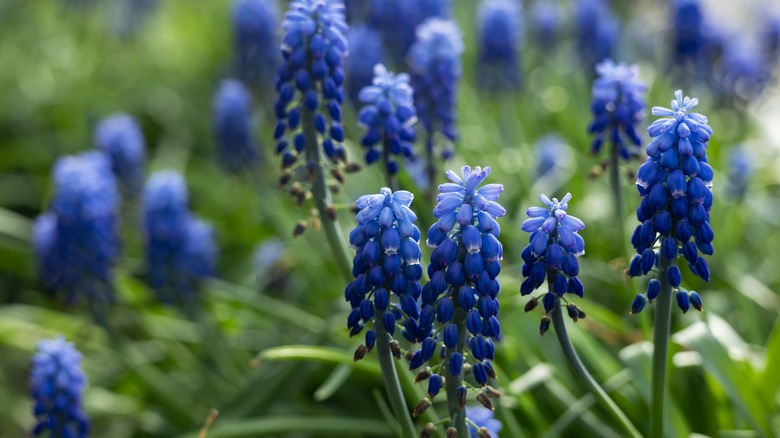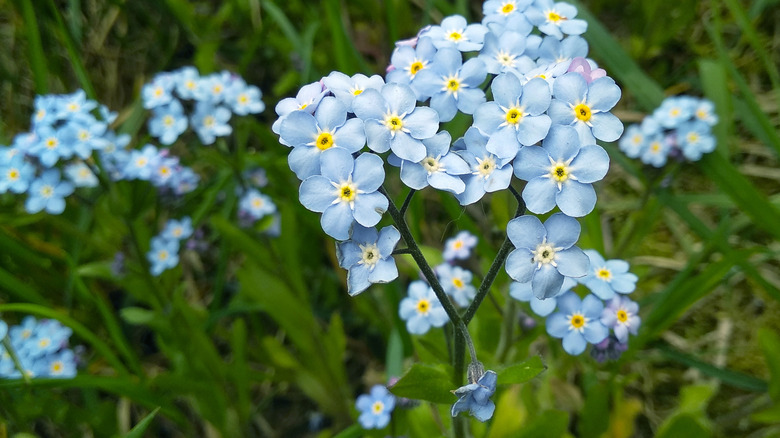16 Flowering Blue Weeds To Avoid Planting In Your Yard
There's something enchanting about blue blooms running through the landscape. In fact, it can be exciting to let a blue-flowering volunteer keep the space. After all, what could go wrong? Turns out, plenty can. While many azure-blooming plants like giant hyssop, anemones, and asters rightly deserve a spot in your yard, several others don't. To put this into perspective, consider blue-flowering plants like violet, cornflower, morning glory, grape hyacinth, and field pansy. They look innocent enough in their initial growth phases, but become a menace in a short time. They overtake desirable plants, through self-seeding or vegetative means, and come up in the toughest spots.
Others like chicory, bugleweed, blueweed, speedwell, and periwinkle, take the pressure up a notch by invading natural areas, ousting native vegetation, and harming the local ecosystem. Moreover, many of these cerulean flowers are difficult to control, burdening gardeners with years of maintenance. So, to save you time, money, and effort, along with helping you protect your landscapes from troublesome invaders, here's a list of 16 blue-flowering weeds you should avoid growing and why.
Chicory can take over the garden through prolific self-seeding
If you adore the taste of coffee, but don't necessarily need the caffeine kick, you may feel tempted to grow chicory (Cichorium intybus) — their roots can be used as coffee substitutes. You may also like it for the velvety, sky-blue petals that appear mid-summer. However, the blue chicory flower is a weed you don't want lurking in your yard.
Chicory produces numerous seeds that remain viable for four years, enabling it to overrun the space. Additionally, these seeds tend to travel to adjoining areas, especially roadsides, agricultural areas, pastures, disturbed sites, or even neglected lawns, through shoes, lawn equipment, or wandering mammals. While the plant hasn't displayed any major takeover of natural lands, it's still classified as a noxious weed or an invasive species across some U.S. states, including Kentucky and West Virginia, and mustn't be planted there. If you've this blue-flowering weed in your yard, pull it out by the root to prevent resprouting. Don't mow the flowers, or the plant will grow prostrate to avoid the blades.
Bugleweed can spread into yards via its rhizomes
Bugleweed (Ajuga reptans) looks pretty in spring gardens when spikes of blue-violet flowers dance above its green foliage. Many gardeners also like it for its ability to quickly occupy dry, shaded spots that are tricky to fill in or become infested with weeds. But before you use bugleweed as a weed-suppressing ground cover, know that it grows quite aggressively and can turn weedy. It accomplishes this by sending stolons from its crown in every possible direction. For this reason, it features on the invasive and weedy lists of Oregon, West Virginia, and Maryland, where it shouldn't be planted at all.
While growing bugleweed is still legal in non-invasive states, it can increase your lawn care chores manifold. Without regular deadheading, removal of runners, and diligent touch-up of edges, it can jump into the turf and riddle it with mini patches of blue flowers, ruining the manicured look. Since banishing weeds from your lawn without harming the grass is usually a complex task, you should either be prepared to spend time on manually yanking out these weeds, or avoid planting them altogether.
Violet seeds freely in moist landscapes
Granted, common blue violets (Viola sororia) provide pollinator value, with several moth and butterfly species laying their eggs on their foliage. Birds, too, nibble their seeds as they ripen during the summer after the blue flowers have exhausted themselves. Unfortunately, this wildlife action doesn't stay limited to the area where these specimens were initially planted — it spreads throughout the garden beds or lawns. Since common blue violets are prolific seeders, they can monopolize the abutting areas and expand their presence indefinitely. And this can be troublesome in small spaces, especially locations featuring moist, fertile soils.
Common blue violets are difficult to eradicate after establishment. Mowing encourages them to adapt and grow shorter to evade the cutters, while hand removal isn't feasible for big patches. Even herbicides offer limited utility and risk harming the neighboring ornamentals. So, unless you don't mind them naturalizing, avoid giving them a spot in your yard.
Speedwell can overtake thinning lawn patches
As a genus, speedwell consists of many varieties, both native and non-native to the U.S. The ones introduced from Europe, such as corn speedwell (Veronica arvensis), ivy-leaved speedwell (Veronica hederifolia), and birdeye speedwell (Veronica persica), tend to grow weedy in landscapes and turfgrasses. They're also known to naturalize in disturbed sites.
Although speedwells make dreary wintry landscapes beautiful through their petite blue blooms, reconsider planting them. Through profuse self-seeding, they colonize the area and ensure their return year after year, despite the mostly annual lifecycle. Plus, they're problematic in poor soil conditions or under-fertilized lawns where the lack of adequate nitrogen restricts the growth of existing plants, allowing the speedwells to outcompete them. These weeds often require repeated herbicide applications for complete eradication.
So, spare yourself undesired yard work and steer clear of introduced speedwell species. In case they're already planted or have been introduced into your yard, mow the emerging flower heads, pull the seedlings, or cultivate the soil. Consider incorporating these 12 ways to transform a lackluster lawn into a stunning green oasis, as vigorous grasses can dominate these flowering weeds.
Asiatic dayflower can colonize the space when the conditions are to its liking
Asiatic dayflower (Commelina communis) is a summer annual that produces pretty, blue flowers through the fall. Since it's a fast grower, with a lone plant covering 10 feet on the ground, it makes for a dainty ground cover in shaded sites. Sadly, it has little respect for boundaries.
Asiatic dayflower recklessly self-sows in shaded, moist soils, with seeds surviving in the soil for over four years. They also reproduce vegetatively, developing roots where stems touch the ground, invading garden beds. They're considered invasive in Kentucky and Virginia, and continue to expand their presence in disturbed and natural sites across eastern and southern U.S. states. They're also becoming a nuisance weed in agricultural fields where they dominate other plantings. In case you find these flowers growing in your landscapes, mow them before seed production, cultivate the soil, or apply flumioxazin-based herbicides.
Blueweed can become aggressive in landscapes
Cousins to borage, blueweed (Echium vulgare) is an attractive plant whose pink buds unfurl to reveal blue-to-purple petals in the most pleasing shades. While some gardeners truly enjoy this wildflower and set it free in lean soils, it's a misfit in formal landscapes.
Blueweed primarily spreads through seeds, which remain viable in the soil for over three years. When these seeds disperse to pastures through wind or animal movement, they harm livestock, especially horses, due to the presence of pyrrolizidine alkaloids in them. Moreover, blueweeds have tough spines that can lodge into the skin and cause irritation. Although tapped for honey production, because bees feed on their flowery nectar, the resultant product is similarly toxic due to the alkaloids and is unfit for long-term consumption. These reasons, taken together, have earned blueweed the label of a noxious weed in the northwestern U.S., including Washington, Wyoming, Idaho, and Montana. It is considered invasive in West Virginia. If you still choose to grow this plant (considering it's safe in your location), be sure to remove the spent blooms before they set seed to limit its spread.
Alkanet becomes invasive in fertile soils
A Mediterranean import, alkanet (Anchusa azurea) is a fast-growing perennial noted for its edible, deep blue flowers that provide summer color, both to the garden and our salad plates. However, if you aren't looking to increase your gardening chores, you may want to sit this one out.
Alkanet, also known as Italian bugloss and anchusa, produces seeds in abundance that readily take to soils if they're rich in nutrients. As a result, they raid through garden beds, necessitating constant weeding. They're also known to escape cultivation and naturalize in the wild in states like Washington and Oregon, and are considered a nationwide weed in the U.S.
If you still want to plant alkanet, locate it in poor or compacted soils where it's less likely to become aggressive. Deadhead the flowers to prevent seed production and encourage reblooming. Alternatively, plant their hybrid cultivars instead, as their seeds aren't viable.
Creeping bellflower chokes out the surrounding vegetation
Creeping bellflower (Campanula rapunculoides) was introduced to the U.S. as a hardy perennial that withstands diverse light conditions and looks excellent when its bluish-purple flowers are on display in the summer. But it has since turned invasive in Minnesota and is considered a noxious weed across several Midwestern states.
Creeping bellflower — as its name denotes — creeps along the ground via underground stems (rhizomes), forming dense stands that choke out the surrounding vegetation. Out in the wild, they displace the native plants and the dependent pollinators. Although many contend that creeping bellflowers also host native pollinators, it's been found that the resultant displacement causes more harm due to lost diversity.
Controlling creeping bellflowers requires immeasurable effort and time. Unless dug at least 6 inches deep, their tuberous rhizomes can remain in the soil and resprout overnight. Plus, these plants produce up to 15,000 seeds in their lifetime, which cannot be easily removed from planted beds. So, to protect the biodiversity and not fall afoul of the local laws, avoid planting this beautiful flower in your garden, or you'll soon regret it. When purchasing wildflower mixes containing Campanula species, double-check that they don't include the invasive one. Some nurseries also mistakenly sell this plant as ladybells (Adenophora liliifolia).
Through re-seeding, cornflower can become a nuisance in gardens
Cornflowers (Centaurea cyanus), or bachelor's buttons, are well-liked for the pop of blue they bring to summer beds with their disked flowers. Their seeds are also commonly placed in wildflower mixes targeted at developing bird-friendly habitat.
Unfortunately, cornflowers can become weedy in the landscape. Their petite blooms make way for numerous seeds that self-sow and root, overrunning annual beds. While you could certainly try to contain their spread through constant deadheading, you'd be denying the birds the seeds they feed on. So, take this into account while weighing the planting decision.
There are also occasions when these seeds have moved into natural areas, agricultural fields, roadsides, and disturbed sites, especially in the eastern U.S. and along the West Coast. They're also classified as an exotic, invasive pest in Georgia and West Virginia, and shouldn't be planted in these states.
Morning glory can become weedy in warm climates
Available in over 600 varieties, morning glory (Ipomoea spp.) vines astound gardeners with their star-marked, funnel-shaped flowers that bloom from summer through frost. The species I. tricolor, and its cultivar 'Heavenly Blue,' turn out azure blue blossoms, while I. indica produces bluish-purple flowers.
Regardless of the variety, morning glory vines are notorious for being heavy self-seeders. While this isn't problematic in cold climates, where the short growth season leaves them little time to become a pest, things are vastly different in warmer areas. Indeed, if the volunteer seedlings aren't removed, morning glories can take possession of the beds, decimating other desirables. If your garden adjoins agricultural fields, these seeds can wreak havoc on crop harvests. Besides, their seeds contain lysergic acids, which are toxic to pets and humans. Due to these factors, morning glories have become noxious weeds or invasive in some U.S. states, including Arizona and California, and are best avoided in those areas.
Periwinkle can overrun planted vegetation
Admittedly, periwinkle (Vinca spp.) has the makings of a nice ground cover — fast growth, ornamental beauty (the bluish-lavender flowers bloom throughout the growing season), drought tolerance, and a dense mat that chokes out weeds. Unfortunately, it doesn't stop there and often turns weedy. Both periwinkle variants — big periwinkle (V. major) and common periwinkle (V. minor) — are invasive or noxious weeds in the eastern U.S. and along the west coast, and are featured on Washington state's monitor list.
Periwinkles spread through vegetative means. Their stems develop roots where they touch the soil, allowing them to colonize the yard. Since these fragments can easily separate from the plant, they can flow down the streams located near coastal gardens, spreading far and wide and claiming natural lands. With their dense foliage, they shade and exclude native plants by preventing their seeds from germinating, thus altering the ecosystem permanently. Their rapid growth also makes it difficult to arrest their spread. Given that, be sure to avoid growing this stunning flowering plant that's secretly a garden nightmare.
Beach vitex is an invasive spreader in coastal sites
Beach vitex, also known as roundleaf chastetree (Vitex rotundifolia), is a popular choice for coastal sites. This is because it can tolerate salt spray and shallow soils, while simultaneously checking soil erosion. It also has the makings of an attractive specimen because of the spring-blooming, purplish-blue flowers.
Sadly, beach vitex's presence has become a source of alarm across the East Coast and southern states, where it's now considered invasive or a noxious weed. By sending runners, it forms clonal colonies and displaces the local vegetation, especially in dunes. From gardens located near water sources, these stem fragments wander to far-off places and initiate colonization. This has deprived many sea turtles and shore birds of their favored nesting sites. Given their adverse impact on the environment and with coastal gardens serving as the springboard for escape, you should skip growing this hardy ground cover shrub. That being said, if you live deeper inland where this plant isn't yet labeled invasive and tends to be well-behaved, you may give it a go in dry, sunny areas. But deadhead the flowers and remove any suckers to prevent unwanted spread.
Field pansy can take possession of patchy turf spots
Field pansies (Viola rafinesquei, syn. Viola bicolor) produce tiny blooms in tandem with spring's arrival, hence the alternative name "Johnny Jump Up." Their petals vary from pale to purple-blue, and can sometimes be entirely creamy white with blue veins running across their length to attract pollinators.
Although field pansies look beautiful in native gardens, they can dominate perennial beds and become weedy. They produce self-pollinating flowers and so can self-sow in the yard. They're especially common in turf, where they're treated as winter annual weeds — shade and good moisture levels fuel their growth. From gardens and yards, their seeds have been known to escape into agricultural fields primarily in the northeast U.S., posing problems to the growers of grains, strawberries, soybeans, and corn.
Given their native origins, field pansies aren't labeled invasive anywhere. However, they can become an annoying presence in gardens if left unchecked. Unless you're up for diligent weeding, avoid growing them or stake them in a meadow or prairie garden where they're free to roam.
Big-leaf lupine has naturalized in the northeast region
Big-leaf lupine (Lupinus polyphyllus) is indigenous to parts of the western U.S., which is why it's also called Washington lupine. As such, it appears highly ornamental in bloom when deep blue-to-purple petals swirl atop the green foliage. It's also famously used to breed hybrid cultivars, like the Russell hybrid (Lupinus x regalis), that offer flowers in tones of purples, pinks, and whites.
However, in areas beyond its native range and northeastern states in particular, big-leaf lupine has become invasive. Apart from spreading in gardens through self-seeding, these plants move out to inhabit natural areas, excluding native vegetation. There, they change the soil profile with their nitrogen-fixing abilities. Worse, big-leaf lupines cross-fertilize with sundial lupine, another native variety, which hosts the endangered Karner blue butterfly. Plants stemming from this process can no longer feed this species' caterpillars, endangering them further. Since big-leaf lupines continue to expand their presence, they're becoming a threat to the local pollinators in the eastern region, who cannot survive on their monocultural stands alone. So, to protect these good guys, avoid growing big-leaf lupine in these areas.
Grape hyacinth can crowd out bed ornamentals
The pictures of a blue river winding through the Netherlands-based Keukenhof bulb gardens that float around spring may have left you wanting to replicate this look in your own garden by planting grape hyacinth (Muscari armeniacum). However, be warned, these cobalt blue flower bearers can become invasive in the gardens and can be tough to banish afterward.
Grape hyacinths produce bulb offsets, which, when left unattended, naturalize in the space, establishing drifts of blue flowers that crowd out the ornamentals sharing the space. They also reproduce through seeds, amplifying the weedy problem, though the flowers won't appear until after four years. If you'd still like to give them a home in your yard, develop the habit of removing spent blooms, so they won't go to seed. Or, rather than planting them in beds, grow them in rows of pots for a similar effusive effect, but sans the reseeding.
True forget-me-not is a noxious weed across the Midwest
If you keep a rain or water garden, or are seeking plants to populate flooded sites, you may have considered growing true forget-me-not (Myosotis scorpioides, formerly Myosotis palustris), a marginally aquatic plant. While its yellow-eyed, blue flowers certainly strike up an inviting persona, especially for butterflies, they can cause environmental damage.
True forget-me-not produces shoots out stolons, which enable it to take possession of the surrounding area. They also produce seeds aplenty, which have dispersed to natural environments, including wetlands, bogs, lakes, and woodlands. These seeds grow into dense mats, suppressing the native herbs. For instance, in Wisconsin, where true forget-me-not is invasive, it has out-competed endangered species like winged monkeyflower (Mimulus alatus) and spike sedge (Eleolcharis intermedia). In light of their aggressive spread, many Midwestern states have declared it a noxious weed, thereby prohibiting its planting to limit further spread.
